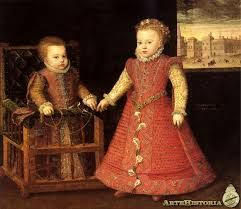
Children's clothing in the Renaissance was very similar to what adults wore, however their clothes were a bit simpler and had sturdier material. The sturdiness was in order to with hold the daily activities of a child, and were simple in order to save money, given the fact that children grow out of clothes very quickly.
Renaissance kids fashion
What is the difference between the dress of children then and today?
The biggest difference in the way of their dress is the meaning. During the Renaissance, it was very important that one's children dressed correctly. If a child was dressed well, the child's family was considered dignified and well-respected among others. However, if a child dressed inappropriately, the child and the family was thought to be poverty-stricken. A typical outfit for a girl from the lower-class consisted of a long-sleeved kirtle worn with ample skirts and a rectangular apron and a headdress. The headdresses varied from either linen coifs and veils to flat caps. An upper-class girl would have worn something along the lines of a gown with a deep "V" neck cut. It could have been laced across the front over a stomacher or black kirtle. Her headdress might only cover the top of her head, allowing her hair to fall freely down her back.

Girls Fashion Compared to Boys Fashion
The girls of the renaissance were always heavily dressed. Commonly, they wore a long, white garment resembling a nightdress (a chemise), stockings, a leather corset, waist-petticoats, a bodice, and a gown over everything. Girls, in addition to women, would always cover their hair with a scarf or hat.
The boys' dress was modeled to resemble their father's attire. They would wear shirts and a fitted jacked (a doublet). They also wore close-fitting hoses (similar to tights), which were tied by lace, and breeches over all layers.
Girls and boys would wear cloaks when it was cold. However, when parents weren't looking, children would remove some layers, making it easier for them to play and move around. This said children wore the majority of their layers on a regular basis.



Infants' Clothing
Babies in the Renaissance had virtually no freedom of movement. Parents wrapped their children in constricting swaddling clothes. They would tie the infant to a cradleboard or carrycot to keep the babies warm or to help limbs to grow straight. Babies also wore corsets called "stays." Young children wore a pudding cap with padding around the forehead in order to act as cushion for the infant's head. Children also usually wore snug fabric biggins caps. Girl and boy toddlers wore gowns with long sleeves. Toddler’s garments often had leading strings attached to the shoulders so that adults would be able to guide children as they learned to walk.


Why was children's clothing so similar to their parents?
The reason that there is not a strong distinction between the dress of children and that of adults is that children, sometimes even toddlers, were expected to act like miniature adults. Childhood was not a supported idea in that time period, at least not in the way that children are encouraged to play and run around and not worry about anything, as children are seen today.








